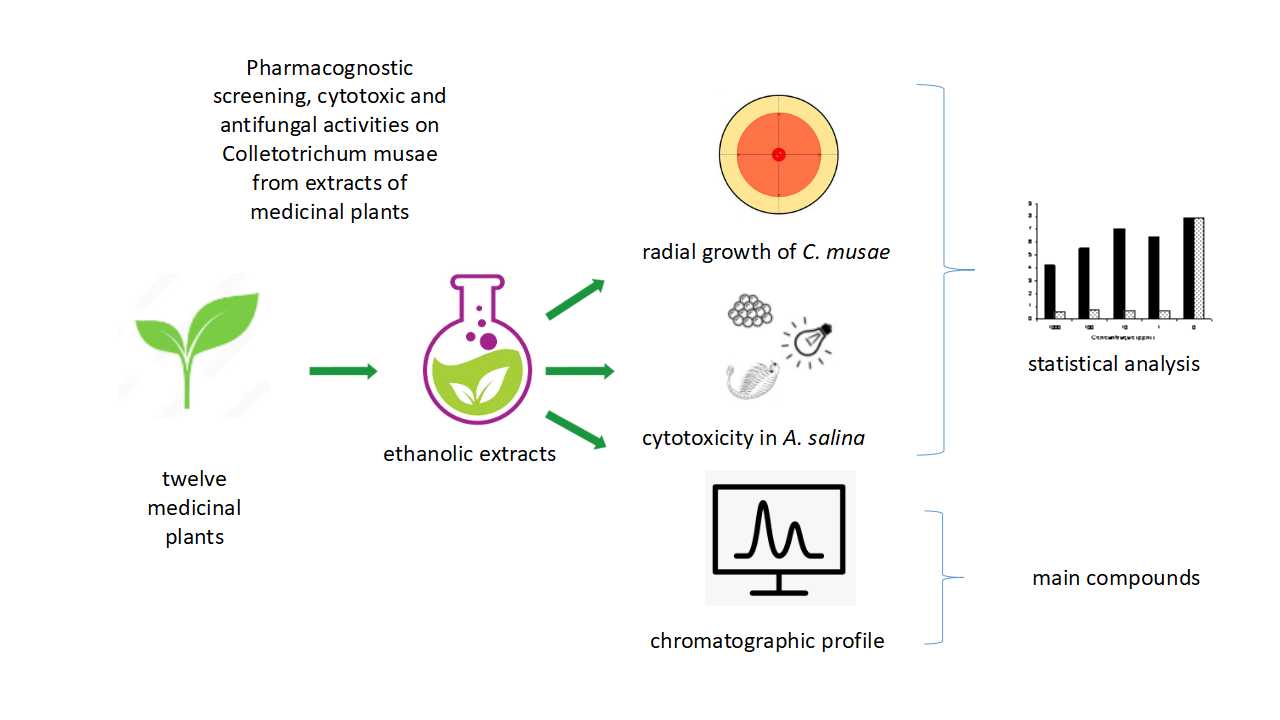Effect of some medicinal plant crude extracts on growth of Colletotrichum musae, causal agent of banana anthracnose
DOI:
https://doi.org/10.70151/49s58r48Keywords:
Alternative Control, Anthracnose, Medicinal PlantsAbstract
Pest and disease control are critical processes for the agricultural industry and typically require the application of large amounts of at least one chemical compound on the plant or soil for treatment. However, herbal extracts can be used to provide crop protection against attack by pathogens, reducing the detrimental and toxic effects on humans and the environment. Therefore, the aim of this study was to assess the in vitro effect of twelve plant extracts PN01 (Alternanthera dentata), PN02 (Alternanthera tenella), PN03 (Ipomoea alba), PN04 (Allamanda blanchetii), PN08 (Lippia alba), PN09 (Plantago major), PN12 (Solanum cordifolium), PN11 (Cecropia glaziovii) PN13 (Solanum torvum), PN17 (Rhizophora mangle), PN18 (Chamomilla recutita) and PN20 (Melissa officinalis) on growth of Colletotrichum musae, post-harvest rot of banana and evaluate the potential cytotoxicity by using Artemia salina model. The extract PN03 showed the greatest potential for control, reducing by 78% in the growth of Colletotrichum musae; PN01, PN04, PN08, PN10, PN12 and PN13 inhibited the fungal growth by 45.5%, 22.9%, 59.1%, 43.8%, 44.3% and 60.0%, respectively. On the other hand, PN11, PN02, PN09 and PN17 did not present activity. Only extracts PN01, PN02, PN10, PN11 and PN12 showed toxicity to brine shrimp. By the analysis of the chromatographic profile, these extracts showed a predominance of polyphenols. Considering these species are found abundantly in the flora, these results may indicate an alternative and accessible control of postharvest rot.
Downloads
References
Arinathan V, Mohan VR, Britto A, Murugan C (2007) Wild edibles used by Palliyars of the western Ghats, Tamil Nadu. Indian J Trad Knowled 6(1):163-168.
Badillo LM, Muñoz RE, Garciglia RS, Pacheco MM (2010) In vitro antioomycete activity of Artemisia ludoviciana extracts against Phytophthora spp. B Latinoam Caribe PL 9(2):136-42.
Bastos CN, Albuquerque OS (2004) Efeito do óleo de Piper aduncum no controle em pós-colheita de Colletotricum musae em banana. Fitopatol Bras 29:555-7.
Cruz-Cruz CA, Ramírez-Tec G, García-Sosa K, Escalante-Erosa F, Hill L, Osbourn AE, Peña-Rodríguez LM (2010) Phytoanticipins from banana (Musa acuminata cv. grande Naine) plants, with antifungal activity against Mycosphaerella fijiensis, the causal agent of black Sigatoka. Eur J Plant Pathol 126(4):459-63.
Dantas SA, Oliveira S, Michereff SJ, Nascimento LC, Gurgel L, Pessoa WR (2003) Doenças fúngicas pós-colheita em mamões e laranjas comercializados na Central de Abastecimento do Recife. Fitopatol Bras 28(5):528-33.
Dixon RA (2001) Natural products and plant disease resistance. Nature 411(6839):843-7.
Ellis BW (1999) Taylor's guide to annuals: how to select and grow more than 400 annuals, biennials, and tender perennials. Singapore: Houghton Mifflin Harcourt.
Fischer SZ, Stumpf ER, Heiden G, Barbieri RL, Wasum RA (2007) Plantas da flora brasileira no mercado internacional de floricultura. Rev Bras Biocien 5(1):510-2.
Gupta MP (2004) Investigaciones farmacognósticas sobre la flora panameña. An R Acad Farm 70(6)839-883.
Haiat SW, Bucay JW (2009) Algunas plantas utilizadas en México para el tratamiento del asma. An Orl Mex 54(4)145-71.
Jacobs T (2002) Underutilized Edible Plants from South Africa. In: Engels JMM et al. (Ed.). Managing Plant Genetic Diversity. Wallingford: CABI Publishing. Underutilized Edible Plants from South Africa. 373-377
Joshi N, Kehlenbeck K, Maass BL (2007) Traditional, Neglected Vegetables of Nepal: Their Sustainable Utilisation for Meeting Human Needs. Tropentag - International Conference for Research on Food Security, Natural Resource Management and Rural Development. TIELKES, E. Gottingen: Cuvillier Verlag. 242-252.
Koepf HH, Pettersson BD, Schaumann W (1986) Agricultura Biodinâmica. 4th. São Paulo: Nobel. 333 p.
Krauss BH (2001) Plants in Hawaiian medicine. Honolulu: Bess Press Inc. 150p.
Meyer BN, Ferrigni NR, Putnam JE, Jacobsen LB, Nichols DE, McLaughlin JL (1982) Brine shrimp: a convenient general bioassay for active plant constituents. Planta Med 45(05):31-4.
Mmutlane EM, Harris JM, Padwa A (2005) 1, 3-Dipolar cycloaddition chemistry for the preparation of novel indolizinone-based compounds. J Org Chem 70(20):8055-63.
Moraes WD, Zambolim L, Lima JD (2006) Incidência de fungos em pós-colheita de banana 'Prata anã' (Musa AAB). Summa Phytopathol 32(1)67-70.
Nguyen VN, Nguyen DM, Seo DJ, Park RD, Jung WJ (2009) Antimycotic activities of cinnamon-derived compounds against Rhizoctonia solani in vitro. Bio Control 54(5):697-707.
Oh KB, Chang IM, Hwang KJ, Mar W (2000) Detection of antifungal activity in Portulaca oleracea by a single‐cell bioassay system. Phytother Res 14(5):329-32.
Oliva SR, Raimondo FM (2002) Plantas raras de la flora ornamental de Sicilia occidental (Italia). Lagascalia 22(1):35-80.
Pott A, Pott VJ, Sobrinho AB (2004) Plantas úteis à sobrevivência no Pantanal. IV Simpósio sobre Recursos Naturais e Sócio-econômicos do Pantanal [Internet]. Corumbá: Embrapa: 1-5 p. 2004.
Queiroz EF, Ioset JR, Ndjoko K, Guntern A, Foggin CM, Hostettmann K (2005) On‐line identification of the bioactive compounds from Blumea gariepina by HPLC‐UV‐MS and HPLC‐UV‐NMR, combined with HPLC‐micro‐fractionation. Phytochem Anal 16(3):166-74.
Salome M, McGaw L, Eloff JN (2009) Plant antifungal extracts active against plant pathogenic fungi. Afr J Tradit Complement Altern Med 4:487-488.
Schwan-Estrada KRF et al. (2006) Controle pós-colheita de Colletotrichum musae em banana (Musa sp.) por cânfora. Rev Sci Agrár Parana 5(1) 57-66.
Sher A (2009) Antimicrobial activity of natural products from medicinal plants. Gomal J Med Sci 7(1).
Silva MB, Rosa MB, Brasileiro BG, Almeida VD, Silva CD (2005) Desenvolvimento de produtos à base de extratos de plantas para o controle de doenças de plantas. Controle alternativo de pragas e doenças. Viçosa: EPAMIG/CTZM. 221-246.
Wagner H, Bladt S (1996) Plant Drug Analysis. 2a. Berlin: Springer-Verlag. 384 p.
Witters WL (1975) Extraction and identification of clavine and lysergic acid alkaloids from morning glories 1. Ohio J Sci 75(4) 198-201.

Downloads
Published
Issue
Section
License

This work is licensed under a Creative Commons Attribution-NonCommercial-NoDerivatives 4.0 International License.

